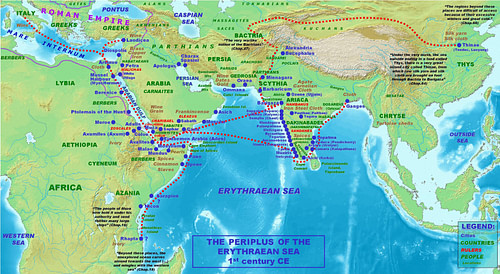It never ceases
to amaze me how far and wide ships in antiquity could travel. Those
seafarers must have been very adventurous and determined to sail to
unknown destinations.
We are far more
familiar with men like Vasco de Gama or Christopher Columbus discovering
faraway lands than Egyptians leaving their hieroglyphs in Australia (The Gosford Glyphs in New South Wales). But
for now, let us stay a little closer to home and trace some of the trade routes
beyond the Mediterranean (see: The flooded remains of Kekova Island), skirting the southeastern coast of Africa, the
southern part of the Arabic peninsula, and Southeast Asia.
A similar itinerary may have already existed in the days of Darius I, who built a canal between 522 and 486 BC that connected
the Nile with the Red Sea (see: The Canal of the Pharaohs, the Suez Canal of antiquity). The foundation stone to
mark the event was discovered in 1866 when the modern Suez
Canal was constructed.
As mentioned
briefly in the present post, the trading activities are based on the Periplus of the Erythraean Sea, written by a Greek merchant from Alexandria
between 40 and 55 AD. The Periplus of the Erythraean Sea has been discussed in detail
by James Hancock in an article published in the World History Encyclopedia,
which highlights the many trade routes and harbors used. The merchant’s diary
is the earliest comprehensive insight into this extensive travel web.
Once Egypt fell into Roman hands in 30 BC, trade
through the ports of the Red Sea increased
dramatically. The principal turnover harbors were Berenice and Myos Hormos, where the goods
arrived on camel caravans from deeper inland. The ships unloaded their cargo
in these same ports from where other caravans brought the incoming goods to
Roman Alexandria
on their return.
Ships heading
for Africa or India, known to leave between July and September, were steered through the middle
of the Red Sea to avoid the dangerous
coastline. Those heading for Africa passed the Horn of Africa and hugged
the coast south to Rapta,
near modern Dar es Salaam.
This voyage took about two years to complete. The trade involved Egyptian
linen, wine, glass, and metal artifacts to be exchanged for African ivory,
tortoiseshell, myrrh, and frankincense. Thanks to the local traders doing
business with India,
the merchants could find cinnamon, Indian fabric, and fine muslin.

The ships bound
for India stopped at the harbor of Aden and
then at Qana
on the southern end of the Arabian Peninsula (today’s Yemen),
where they took advantage of the monsoon winds to sail across the Indian Ocean
to India.
Barbaricum was their first harbor near modern Karachi on the Indus River. Here, they unloaded their cargo of Egyptian linen,
wine, glass vessels, silver and gold plates, frankincense, coral, and topaz. In
exchange, they loaded cotton fabric, silk yarn, turquoise, lapis lazuli, indigo,
nard (a kind of spikenard), and other herbs like costus and lyceum (Greek lykion). As the
Romans’ confidence grew, the sailors ventured further south to Muziris on the Malabar
Coast and hence to Sri Lanka.
The Tamils of the island traded their pepper for gold. Black pepper seemed very popular as it constituted about three-quarters of the homebound
cargo! The mainland Indians gladly offered ivory and pearls, whereas silk
and semi-precious stones were brought in from as far as the Valley of the
Ganges and the Himalayas.
It is
astonishing how all this knowledge and trade faded away in the Middle Ages when
men like Vasco da Gama and other intrepid seafarers had to rediscover it.


No comments:
Post a Comment